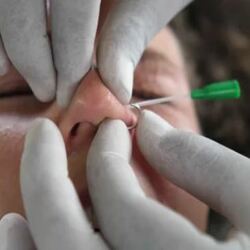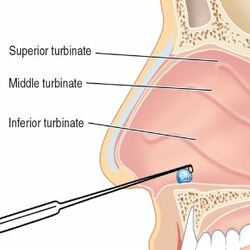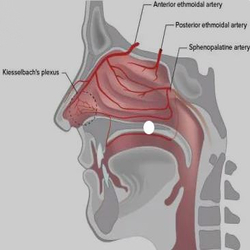NOSE
I & D of abscess
Incision and drainage (I&D), also known as clinical lancing, conducted as an OPD procedures are Minor surgical procedures to release pus or pressure built up under the skin, such as from an abscess, boil, or infected paranasal sinus.
It is performed by treating the area with an antiseptic solution generally based of Iodine, followed by making a small incision to puncture the skin using a sterilised instrument such as a sharp needle or a pointed scalpel. This vents out the pus fluid to drain out through the incision.

Nose pricking by needle prick

Nose pricking is generally done a lady primarily cosmetic reason. To add on to the ornamental value of using the nose ring or a stud as the case maybe.
Chemical cautery
Chemical cautery is a procedure of burning a small part of a body. It removes an undesired growths like skin tags, warts, milia and molluscum contagiosum.
Many chemicals can destroy tissue, and some are used routinely in medicine, most commonly for the removal of small skin lesions. Doctor can use different concentrations of TCA for different sites and type of lesions. Higher percentage of TCA indicates stronger effect of TCA. Carbolic Acid (Phenol) Chemical cautery.

Nasal bleeding

The nasal bleeding is primarily due to the damage to the tissues or minor ruptures. The Most common reasons of a nasal bleeding are,
i) Picking your nose, particularly if you scratch the inside of your nose with a sharp fingernail.
ii) Blowing your nose very hard.
iii) A minor injury to your nose. A blocked or stuffy nose often caused by an infection such as a cold or flu.
iv) Dry air, when your nasal membranes dry out, they’re more susceptible to bleeding and infections.
Foreign body removal
The most used is direct visualization and extraction using instrumentation, like Curettes, Alligator forceps, Cupped forceps, Probes, Haemostats, curved hooks, eustachian tube catheters and Endoscopic retrieval devices, such as the Roth Net retriever.
Besides which Nasal foreign bodies are removed by several techniques. Positive-pressure expulsion is accomplished by orally applied pressure via a parent’s mouth or an Ambu bag or by nasally applied pressure via a catheter or an oxygen source.

Anterior Nasal Packing

After a nasal injury or surgery, gauze is sometimes packed high up inside the nasal cavity after numbing the nasal area, this soaks up fluids that drain from the nose, such as blood. The gauze is douse in an antibiotic ointment and a medication that squeezes the blood vessels shut.
The doctor may opt to change the gauze or leave it in place for a few days.
Anterior nasal packing for anterior epistaxis is indicated for bleeding that has not resolved after the application of direct pressure, vasoconstrictive medications, and cautery.
Diagnostic Nasal Endoscopy (DNE)
Diagnostic Nasal Endoscopy involves evaluation of the nasal and sinus passages with direct vision using a magnified high-quality view. It is a commonly performed procedure in the otolaryngologist’s office and serves as an objective diagnostic tool in the evaluation of nasal mucosa, sinonasal anatomy, and nasal pathology. Nasal endoscopy may be accomplished with either a flexible fibreoptic endoscope or a rigid endoscope
The nasal endoscope is a thin, rigid, or flexible tube with an attached light source, which is passed through the nostril to evaluate the deeper internal nasal anatomy, central airway and lateral or posterior aspects of the nasal cavity and sinuses.
